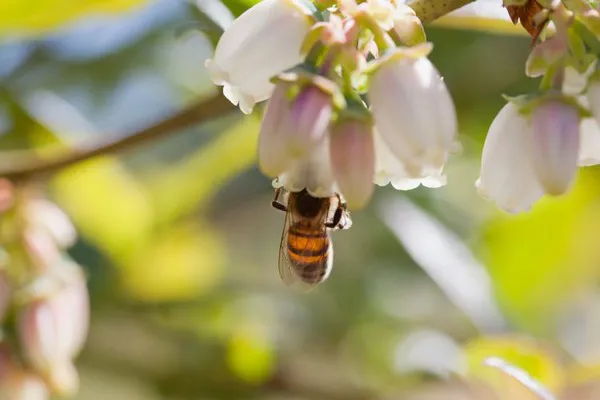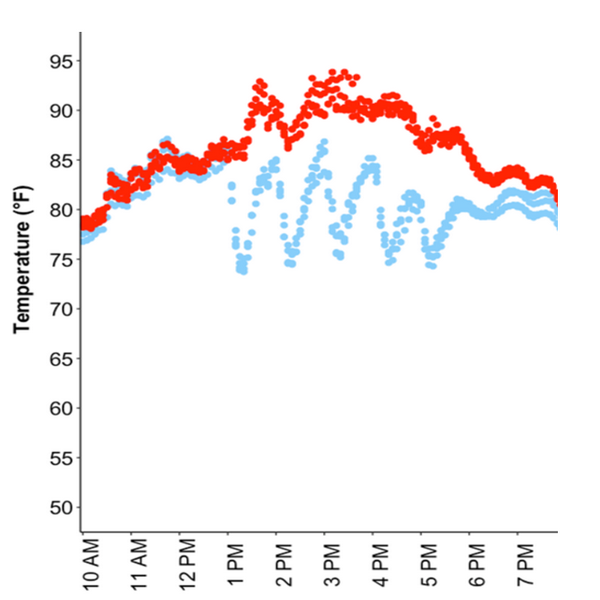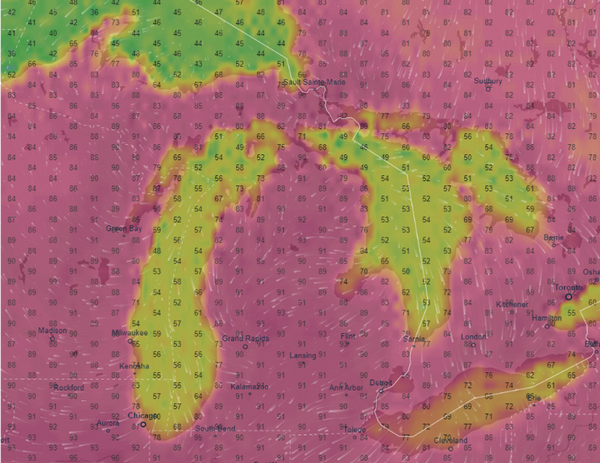Michigan’s blueberry industry has been increasingly affected by climate change with spring heatwaves, long dry periods and heavy rains all causing a potential for yield losses.
To illustrate this, in February-March 2012 daily high temperatures were the hottest on record since 1880, according to the National Oceanic and Atmospheric Administration (NOAA). Temperatures advanced blueberry growth by more than three weeks, exposing blueberry bushes to frost damage which also reduced the abundance of pollinators. According to Michigan State University Extension, in 2018 and 2022 drought conditions reduced blueberry yields by as much as 40%. This situation is not unique to Michigan, as there are examples of the heat dome and early spring impacts in the Pacific Northwest region, too.

MSU research by graduate student Jenna Walters working with Rufus Isaacs is finding that blueberry pollen germination in varieties like Bluecrop, Elliott and Jersey is reduced when air temperatures are at or above 90 degrees Fahrenheit (32 degrees Celsius). To prevent this, evaporative cooling can reduce field temperatures to prevent these damaging conditions, with the evaporation of water and mist from the sprinkler or microsprinklers pulling heat from the plant canopy creating a microclimate that is below the critical temperatures. This is expected to favor better pollination and fruit growth.
Our tests of running overhead irrigation at the Trevor Nichols Research Center indicate that this will effectively reduce the air temperature by 5-10 F. In a recent trial, we ran water for 15 minutes of each hour once the air exceeded 85 F (29 degrees Celsius). This follows a protocol developed at Oregon State University for summer cooling of fruit. This approach kept the air temperatures below 90 F through the hot period of the day. According to that research by Yang and Bryla, overhead sprinklers or microsprinklers are equally effective for cooling, but microsprinklers used less water. In spring when blueberries are in bloom, the water in ponds is colder than in summer, so it has greater cooling capacity. Additionally, running it for 15 minutes can save water compared to continuous running.
 Figure 1. Air temperatures in a blueberry field at the Trevor Nichols Research Center in Fennville, Michigan. The overhead irrigation was turned on for 15 minutes every hour when the air temperature reached 85 degrees Fahrenheit (29 degrees Celsius). The irrigation system dropped the air temperature by about 10 F (5.5 C), which was enough to reduce conditions below the temperature where pollen damage will occur.
Figure 1. Air temperatures in a blueberry field at the Trevor Nichols Research Center in Fennville, Michigan. The overhead irrigation was turned on for 15 minutes every hour when the air temperature reached 85 degrees Fahrenheit (29 degrees Celsius). The irrigation system dropped the air temperature by about 10 F (5.5 C), which was enough to reduce conditions below the temperature where pollen damage will occur.
Saving the crop is the primary goal, but applying water may also increase the risk of disease. This can be addressed using a post-irrigation fungicide application. Typically, the extreme weather is only one or two days, and there will be plenty of other hours during these days when bees can effectively visit the flowers to achieve pollination.
With current hot spring weather conditions we are experiencing in west Michigan (Figure 2), results from our recent research suggests keeping a careful eye on the weather forecast during bloom and using your overhead irrigation to cool down fields when predicted temperatures are expected to exceed 85 F (29 C). Keep the irrigation system running until the air temperature drops back down to 85 F. This is especially important for fields with black weed fabric that can significantly increase the air temperature, especially in the bottom section of the plant canopy.
 Figure 2. Predicted high air temperatures for June 2, 2023, across the state of Michigan. High temperatures near above 90 F will be observed in multiple blueberry producing counties. Image generated by www.ventusky.com.
Figure 2. Predicted high air temperatures for June 2, 2023, across the state of Michigan. High temperatures near above 90 F will be observed in multiple blueberry producing counties. Image generated by www.ventusky.com.
Source: canr.msu.edu
